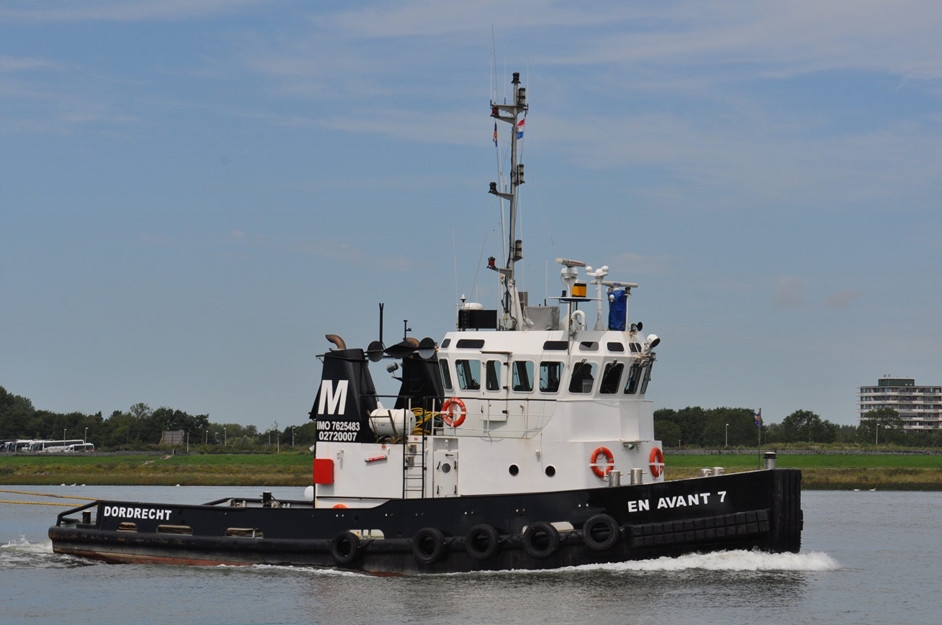Both the captain of the En Avant 7 and the captain of the En Avant 30, who was on board the En Avant 7 as a lookout during a fatal accident, have had their sailing licences suspended. The Maritime Disciplinary Court of the Netherlands has found both men were in part to blame for the accident.
On 25 August 2021, at about 11.09 pm LT, a very serious accident occurred on board the tug En Avant 7. This killed a seafarer and injured a trainee. The accident took place in the Central Dockyard at Moerdijk, the Netherlands. The En Avant 7 was performing a port assistance, as an aft tug. The seagoing vessel, which was being assisted, was the Tia Marta. The En Avant 4 was involved as forward tug.
The Tia Marta was pulled backwards out of the Eastern Dockyard to be turned into the swinging circle of the Central Dockyard and then forward towards the Zuid-Hollands Diep. During this manoeuvre, the seaman and the trainee became trapped between the towing line and the accommodation. The sailor died of his injuries almost immediately. The trainee broke two ribs.
The En Avant 7 (IMO number 7625483) is a traditional Dutch tugboat (with two fixed propellers), owned by shipping company Muller, Dordrecht. The vessel was built in 1981, is 22.5 metres long and 6.8 metres wide, has a gross tonnage of 108 T and a power of 1176 KW. At the time of the accident, the crew consisted of a total of four persons.
In addition to the seafarer and trainee, this was the captain of the En Avant 30, who had been asked to come on board as lookout, and the captain. At the time, the captain was in the final stage of his training programme as captain.
Also read: What can be taken away from the fatal accident aboard tug En Avant 7?
Captain’s actions found wanting
The Maritime Disciplinary Court of the Netherlands has found that both the captain and lookout fell short in their actions.
When it comes to the captain, the Court says that he allowed the vessel to swing too far when manoeuvring. In addition, he was insufficiently aware of the position of the En Avant 7 in relation to the Tia Marta, the position of the towing line and the position of the deck crew. He did not sufficiently coordinate with the captain of the En Avant 30 as to who would be watching what and how they would communicate about it.
Finally, he only complied with the rules of ocean going vessels in terms of minimum manning requirements, where he should also have complied with inland navigation regulations. According to the Court, it was primarily the responsibility of the shipowner to properly man the ship. However, this does not alter the fact that even a master acts unseemly when provisions intended to observe the safety of those on board, the ship, the cargo, the environment and shipping traffic are ignored.
Breach of good seamanship
As to the master of the En Avant 30, the Court states he was insufficiently aware of the position of the En Avant 7 in relation to the Tia Marta and the position of the towing line. In addition, no agreements were made on how to communicate with the captain and the communications that did take place were too brief.
Moreover, the court found, that as master of the En Avant 30, but at the time of the conduct temporarily employed with officer duties on the En Avant 7, he should have acted as a good seaman towards those on board, the vessel, the cargo, the environment and shipping traffic.
Also read: Captain Beaumaiden loses licence for two years after causing grounding
Sentencing
The captain of the En Avant 30 received a four-month suspension of which two months were suspended. For the captain of the En Avant 7, it is six months’ suspension of which four are conditional. Both receive a probation period of two years.
In reaching its verdict, the Disciplinary Court took into account the captain’s lack of experience and a lack of coaching by the shipping company.
In addition, the Court notes that with new tugs, an accident like the one with the En Avant 7 is virtually impossible, as the tow rope runs through an eye on the bow to the winch on the bow and it can be shortened and operated from the wheelhouse.
Picture by the Dutch Safety Board.








